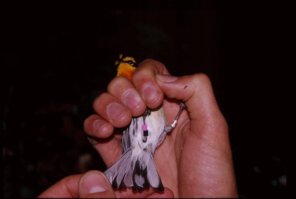|
Habitat Requirements of Forest Birds in the Greater Fundy Ecosystem
Matt Betts, Greater Fundy Ecosystem Research Group (email: mgbetts@nbnet.nb.ca)
Dr. Tony Diamond, Atlantic Cooperative Wildlife Research Network (email:
diamond@unb.ca)
The primary goal of this project is to develop scientifically-based habitat
associations for birds that are currently listed as New Brunswick Department
of Natural Resources and Energy (DNRE) vertebrate indicator species. This
knowledge will help determine the effectiveness of existing indicators
that serve as a basis for forest and wildlife management on Crown land.
Because habitat associations of indicator species (at the stand and landscape
levels) ultimately affect both the type and extent of forestry activities
that occur on Crown land, the fulfilment of this goal will significantly
contribute to the conservation of forest birds in New Brunswick.
This project has three major objectives:
- Determine aspatial (stand structure, stand composition) habitat
relationships for DNRE avian indicator species. This includes such
stand attributes as vegetative species composition and the size and
physical distribution of species within the stand.
- Determine spatial (patch size) habitat requirements of avian indicator
species.
- Examine aspatial and spatial habitat requirements for a range of
other bird species to determine if they might serve as better indicator
species in upcoming forest management planning exercises.
Information generated by this research is likely to be integrated into
DNRE's current planning process for forest management on Crown land.
Three main methods will be adopted in this study: (1) point counts will
be used to determine abundance of forest bird species, (2) the mobbing
playback method will be used to estimate reproductive success, and (3)
nest and fledgling monitoring will provide a basis for calibration/ verification
of the playback method.

Male Blackburnian Warbler banded in Fundy National Park, summer 2000
Click
to Return to the Main Page
|

